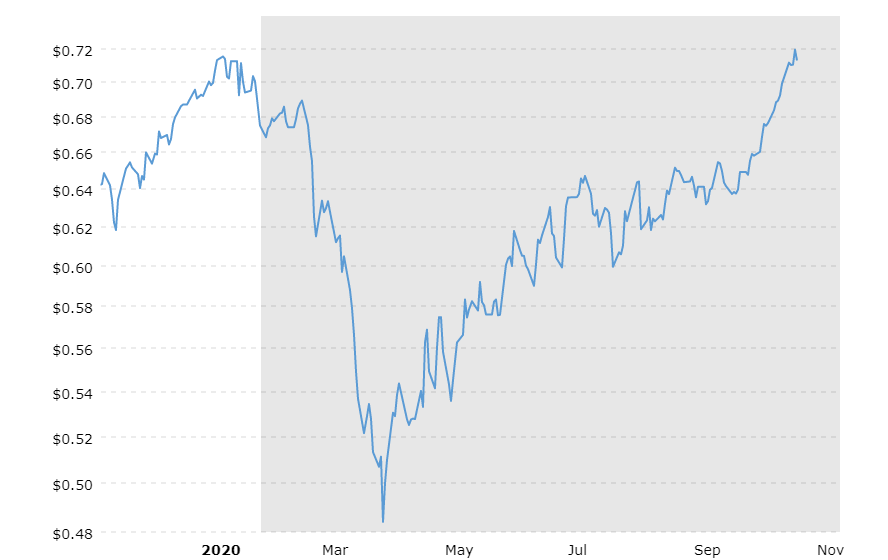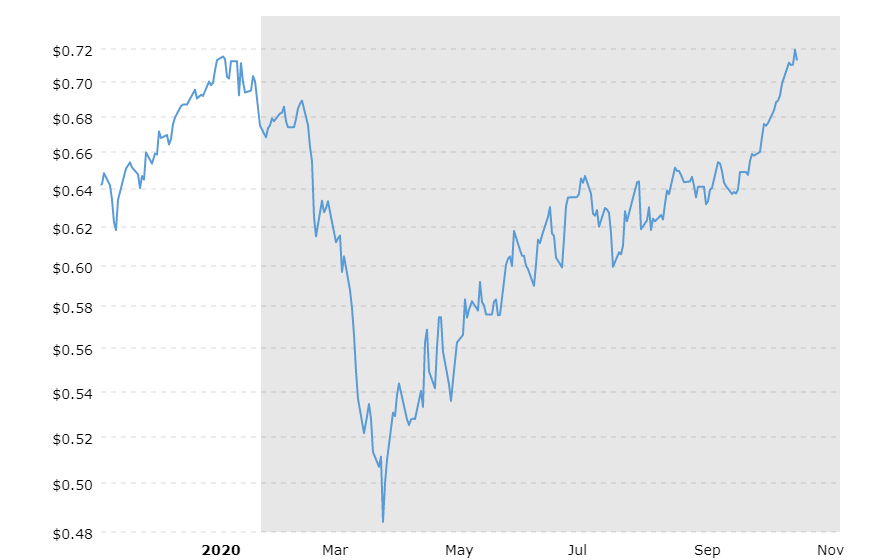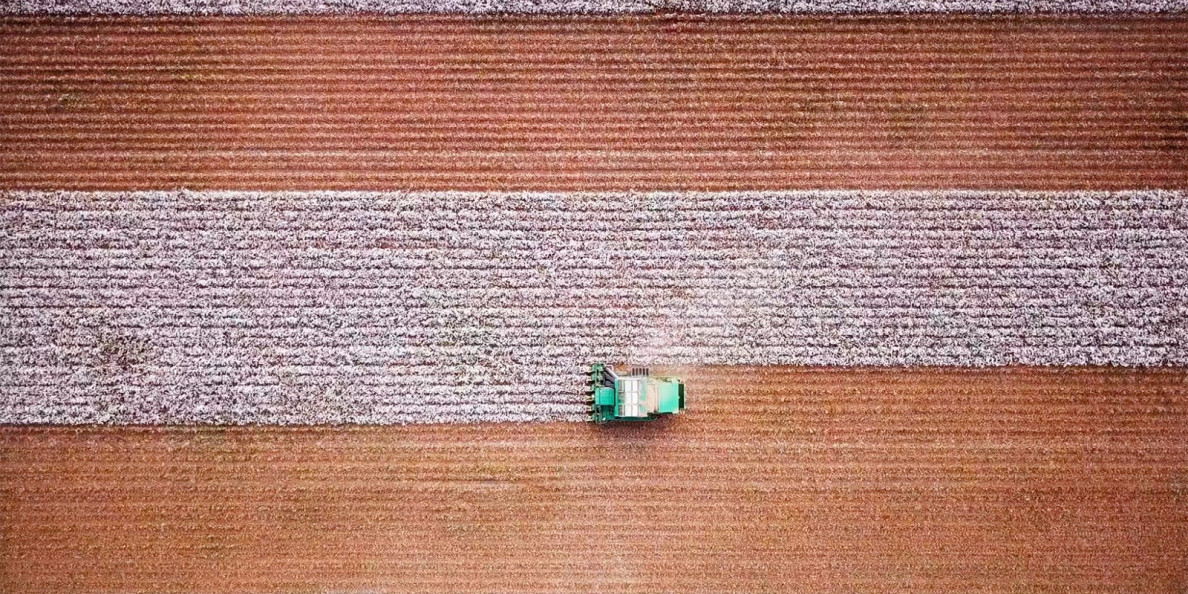Summary
Cotton production projections lowered for the 2020/21 season.
The output from major growing countries projected to decrease.
Demand forecast to recover in the 2020/21 season.
Cotton is notably one of the world’s most traded commodities, produced for its fibre that is used as a textile raw material globally. This fluffy commodity is grown in over 100 countries, and approximately 150 countries are involved in exports and or imports. As the year began, cotton futures performed relatively well and traded above $0.69 per pound.
The surge in price was primarily driven by lower exports from the world’s top exporter India, as a result of higher domestic prices. Futures tumbled to their lowest on April 1, 2020 trading below $0.50 per pound, due to a decrease in demand, futures have recovered since then.

Source: MacroTrends
Cotton futures have rebounded from their decline and are currently trading above $0.69 per pound. In this article, I will discuss why I expect an increase in cotton prices. First, production is forecast lower for the 2020/21 season. Finally, I will discuss the projected recovery in demand.
Investing in the Ipath Series B Bloomberg Cotton Subindex Total Return ETN (BALB) is a way for investors to track cotton futures higher and lower without the need for a futures account.
Cotton Production Projected Lower in the 2020/21 Season
Cotton production in the 2020/21 season is forecast at approximately 117 Million 480-pound bales, a 5% decline compared to the 2019/20 season. The decrease in output is due to a decrease in production from top growing and exporting countries, the U.S, Brazil, and a slight movement in production from China.
In the 2020/21 season cotton production in the U.S is forecast at approximately 17 million 480-pound bales, a decrease compared to the 2019/20 season where production estimates were 19 million bales. The decrease in output is due to lower acreage and harvests. In the 2020/21 season, 12.12 million acres were reserved for planting, compared to the previous season’s 13.74 million acres.
The cotton output from Brazil is forecast lower in the 2020/21 marketing year to approximately 12 million bales, compared to the 2019/20 season where output was approximately 13.4 million bales, a 1.4 million decrease. The decrease in output is due to a decrease in planted area, from key growing states in Brazil.
Earlier this year, the impact of the pandemic on cotton demand and prices, drove Brazilian farmers from Mato Grosso and Bahia, Brazil’s largest cotton-growing states, to reduce cotton acreage by 10% to 20%, allocating the acres toward soybean and corn planting.
Cotton production from China is forecast to remain flat in the 2020/21 season, to approximately 5.8 MMT compared to the 2019/20 season where production estimates were 5.9 MMT. The decrease in output is mainly based on a lower planted area. China’s Ministry of Agricultural and Rural Affairs (MARA), estimated cotton acreage at 3.21 MHa in the 2020/21 marketing year, a decrease compared to the previous marketing year acreage which was approximately 3.3 MHa.
Despite an increase in projected production from India, India's top producing state Gujarat is forecast to have lower output. The output from Gujarat, India’s key cotton-growing state, accounting for nearly 30% of India’s total output, is forecast lower as farmers opted to shun the fibre crop due to lower prices as a result of the pandemic, thus allocating more land to groundnut production, as prices were more lucrative, and planting conditions were favorable.
Aside from allocating more land to other profitable crops, sowing is forecast lower as farmers reported approximately 60% to 70% of their crop was destroyed by continuous rain. The output is forecast higher from India in the 2020/21 season, but I believe output will be moderately lower than projections, as output forecasts have been revised lower from the country’s top growing state.
The projected decrease in output, from major growing countries and India's top growing state, will have a positive impact on cotton futures during Q4 of 2020.
Demand Forecast to Rebound
Cotton mill use in the 2020/21 season is projected to recover by nearly 10% to 114 million bales, from the previous season’s estimate of 102 million bales. The global cotton supply chain was impacted by the rapid spread of the pandemic earlier this year, as major cotton consuming countries imposed nationwide lockdowns, thus impacting demand. Cotton mill use unexpectedly decreased from China, India, Pakistan, and Bangladesh, as the pandemic impacted consumer demand for textile and apparel.
Countries globally implemented strategies to curb the pandemic. Amongst the strategies imposed was the temporary suspension of non-essential businesses, and the textile and apparel industry was amongst them and as a result, retail sales of clothing and textile plummeted, thus directly impacting cotton futures.
Cotton futures were relatively low during H1 of 2020, due to limited demand. Prices recovered during H2 of 2020, as most countries eased up on the strict policies implemented, and consumer confidence regained as they adjusted to the “new normal”.

Source: MacroTrends
In the 2020/21 season, cotton mill use by all major countries is forecast to rebound. China’s cotton consumption is forecast to recover to 8 MMT, compared to the previous marketing year’s figure which was approximately 7.3 MMT, as a result of the projected recovery of local and international demand for textile and apparel. Cotton imports are forecast higher as China is set to be the leading importer of this fluffy commodity globally as import forecasts are approximately 9 million bales, a 24% increase compared to the previous season.
India’s cotton mill use is forecast to recover to approximately 23 million 480-pound bales, an increase m/m, and a notably higher increase compared to the previous marketing year estimate of 20 million bales. Spinning mills have resumed approximately 75%-80% operation, due to an increase in international demand for the fluffy fibre.
Domestic consumption is forecast to recover at a slower pace, as most consumers are eluding retail stores due to COVID-19 concerns. Cotton consumption from Bangladesh, Vietnam, and Turkey are forecast higher in the 2020/21 season, to approximately 7.3 million, 6.8 million, and 7 million, 480-pound bales.
Cotton imports are forecast higher from Bangladesh and Vietnam to 7.30 million, and 6.80 million, 480-pound bales respectively. Cotton mill use by major consuming countries is forecast to recover in the 2020/21 season, thus I believe this will positively impact cotton futures.
Investment Risk
India, the world’s largest cotton producer, is forecast to increase production in the 2020/21 marketing year to approximately 30 million 480-pound bales, an increase compared to the previous season’s estimate of 29 million bales. The rise in output is driven by an expansion in the acreage of the fibre crop, and adequate rainfall in key producing states.
During the planting season, 12.9 million hectares were reserved for cotton, a 2% increase on year, and nearly 90% of the area is under Bt cotton. Despite the decrease in output from India's top producing state, other key producing states have reported an increase in output. If production projections are realized, the increase in output from India will impact cotton futures.
Conclusion
Cotton futures in the 2019/20 season were negatively impacted by measures implemented, by major producing and consuming countries, to curb the pandemic. Demand was relatively low, and this played a significant role in the price decline. Supply is forecast lower in the 2020/21 season, demand is forecast to recover, and thus I believe cotton futures are set to rebound.
Disclosure: I/we have no positions in any stocks mentioned, and no plans to initiate any positions within the next 72 hours. I wrote this article myself, and it expresses my own opinions. I am not receiving compensation for it (other than from Seeking Alpha). I have no business relationship with any company whose stock is mentioned in this article.


